Related Research Articles
Handloading, or reloading, is the practice of making firearm cartridges by assembling the individual components, rather than purchasing mass-assembled, factory-loaded ammunition.

A cartridge, also known as a round, is a type of pre-assembled firearm ammunition packaging a projectile, a propellant substance and an ignition device (primer) within a metallic, paper, or plastic case that is precisely made to fit within the barrel chamber of a breechloading gun, for convenient transportation and handling during shooting. Although in popular usage the term "bullet" is often used to refer to a complete cartridge, the correct usage only refers to the projectile.

The .40 S&W is a rimless pistol cartridge developed jointly by American firearms manufacturers Smith & Wesson and Winchester in 1990. The .40 S&W was developed as a law enforcement cartridge designed to duplicate performance of the Federal Bureau of Investigation's (FBI) reduced-velocity 10mm Auto cartridge which could be retrofitted into medium-frame semi-automatic handguns. It uses 0.40-inch (10 mm) diameter bullets ranging in weight from 105 to 200 grains.

The .45 ACP, also known as .45 Auto, .45 Automatic, or 11.43×23mm is a rimless straight-walled handgun cartridge designed by John Moses Browning in 1904, for use in his prototype Colt semi-automatic pistol. After successful military trials, it was adopted as the standard chambering for Colt's M1911 pistol. The round was developed due to a lack of stopping power experienced in the Moro Rebellion in places like Sulu. The issued ammunition, .38 Long Colt, had proved inadequate, motivating the search for a better cartridge. This experience and the Thompson–LaGarde Tests of 1904 led the Army and the Cavalry to decide that a minimum of .45 caliber was required in a new handgun cartridge.

The .357 SIG is a bottlenecked rimless centerfire handgun cartridge developed by the Swiss-German firearms manufacturer SIG Sauer, in cooperation with ammunition manufacturer Federal Premium. The cartridge is used by a number of law enforcement agencies.

The .357 Smith & Wesson Magnum, .357 S&W Magnum, .357 Magnum, or 9×33mmR is a smokeless powder cartridge with a 0.357 in (9.07 mm) bullet diameter. It was created by Elmer Keith, Phillip B. Sharpe, and Douglas B. Wesson of firearm manufacturers Smith & Wesson and Winchester. The .357 Magnum cartridge is notable for its highly effective terminal ballistics.
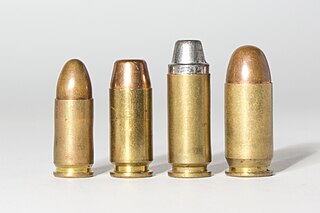
The 9×19mm Parabellum is a rimless, tapered firearms cartridge.
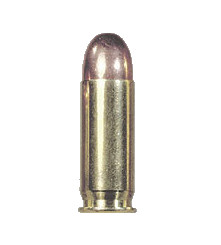
The .38 Super, also known as .38 Super +P, .38 Super Auto, .38 Super Automatic, .38 Super Automatic +P, or 9×23mmSR, is a pistol cartridge that fires a 0.356-inch-diameter (9.04 mm) bullet. It was introduced in the late 1920s as a higher pressure loading of the .38 ACP, also known as .38 Auto. The older .38 ACP cartridge propels a 130-grain (8.4 g) bullet at 1,050 ft/s (320.0 m/s), whereas the .38 Super pushes the same bullet at 1,280 ft/s (390.1 m/s). The .38 Super has gained distinction as the caliber of choice for many top practical shooting competitors; it remains one of the dominant calibers in IPSC competition.

The .22 Long Rifle or simply .22 LR or 22 is a long-established variety of .22 caliber rimfire ammunition originating from the United States. It is used in a wide range of rifles, pistols, revolvers, and submachine guns.
The .30-06 Springfield cartridge, 7.62×63mm in metric notation, and called the .30 Gov't '06 by Winchester, was introduced to the United States Army in 1906 and later standardized; it remained in military use until the late 1970s. The ".30" refers to the caliber of the bullet in inches, .300 and the "06" refers to the year the cartridge was adopted, 1906. It replaced the .30-03, 6mm Lee Navy, and .30-40 Krag cartridges. The .30-06 remained the U.S. Army's primary rifle and machine gun cartridge for nearly 50 years before being replaced by the 7.62×51mm NATO and 5.56×45mm NATO, both of which remain in current U.S. and NATO service. It remains a very popular sporting round, with ammunition produced by all major manufacturers.

The .38 S&W, also commonly known as .38 S&W Short, 9×20mmR, .38 Colt NP , or .38/200, is a revolver cartridge developed by Smith & Wesson in 1877. Versions of the cartridge were the standard revolver cartridges of the British military from 1922 to 1963. Though similar in name, it is not interchangeable with the later .38 Special due to a different case shape and slightly larger bullet diameter.

.455 Webley is a British handgun cartridge, most commonly used in the Webley top break revolvers Marks I through VI. It is also known as ".455 Eley" and ".455 Colt".
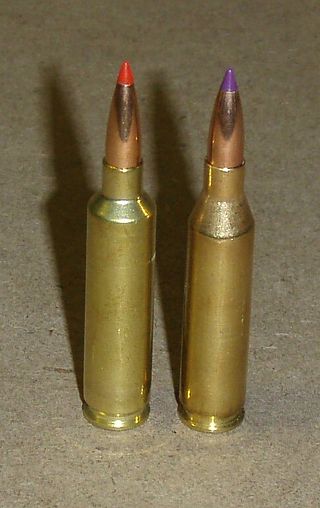
A wildcat cartridge, often shortened to wildcat, is a custom cartridge for which ammunition and/or firearms are not mass-produced. These cartridges are often created in order to optimize a certain performance characteristic of an existing commercial cartridge, or may merely be intended as novelty items.

The 7.92×57mm Mauser is a rimless bottlenecked rifle cartridge. The 7.92×57mm Mauser cartridge was adopted by the German Empire in 1903–1905, and was the German service cartridge in both World Wars. In its day, the 7.92×57mm Mauser cartridge was one of the world's most popular military cartridges. In the 21st century it is still a popular sport and hunting cartridge that is factory-produced in Europe and the United States.
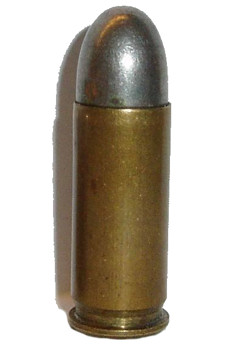
The .38 ACP, also known as the .38 Auto or 9x23mmSR, is a semi-rimmed pistol cartridge that was introduced at the turn of the 20th century for the John Browning-designed Colt M1900. It was first used in Colt's Model 1897 prototype, which he did not produce. The metric designation for the round is 9×23mm SR (semi-rimmed), which is not to be confused with other 9×23mm cartridges.

The 9×25mm Dillon is a pistol wildcat cartridge developed for use in USPSA/IPSC Open guns. The cartridge is made by necking down a 10mm Auto case to 9 mm.
The .45 Mars Long is an experimental centerfire pistol cartridge developed in the late 19th century. The similar .45 Mars Short used the same cupro-nickel-jacketed bullet in a case shortened to 0.66 inch. The bullet has two deep cannelures, and the case is crimped into both. The case mouth is chamfered on the outside to fit flush into the forward cannelure. The cartridge headspaces on this conical forward crimp. This elaborate bullet seating was necessary to withstand the violent feed mechanism of the Mars Automatic Pistol. The case has a thin rim and deep extractor groove in comparison to most rimless pistol cartridges. The Mars cartridges were publicized as the most powerful handgun cartridges through the early 20th century, but fewer than 100 pistols were made and manufacture ceased in 1907. Ballistically the cartridge falls between the .45 Super and .45 Winchester Magnum.
The 9 mm Mars is an experimental centerfire pistol cartridge developed in the late 19th century based on necking down the .45 Mars Long case. The bullet has two deep cannelures, and the case is crimped into both. The case mouth is chamfered on the outside to fit flush into the forward cannelure. This elaborate bullet seating was necessary to withstand the violent feed mechanism of the Mars Automatic Pistol. The cartridge headspaces on the shoulder adjacent to the neck. The case has a thin rim and deep extractor groove in comparison to most rimless pistol cartridges. There was a very similar 8.5mm Mars cartridge firing a 139 grain bullet at 1550 feet per second. The Mars cartridges were publicized as the most powerful handgun cartridges through the early 20th century; but less than 100 pistols were made and manufacture ceased in 1907.
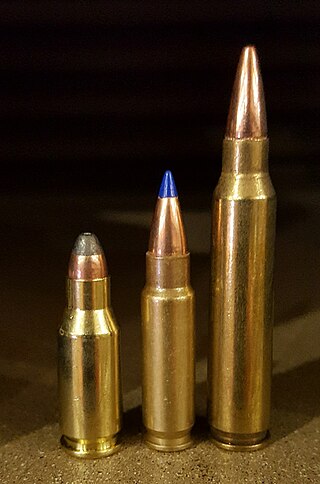
The .22 TCM or 22TCM is a proprietary bottle-necked cartridge created from a 5.56 NATO cartridge developed by custom gunsmith Fred Craig and Rock Island Armory (RIA) for semi-automatic pistols and the Rock Island M22 TCM bolt-action rifle. Before the cartridge was commercialized, it was called the 22 Micro-Mag. Similar conceptually to other bottle-necked pistol cartridges such as the larger-caliber .357 SIG, the .22 TCM trades bullet mass for increased velocity and lowered recoil.
References
- 1 2
- Wilson, R. K. Textbook of Automatic Pistols, pp.236-237. Plantersville, SC: Small Arms Technical Publishing Company, 1943.
- ↑ 8.5x26 Mars / MUNICION.ORG